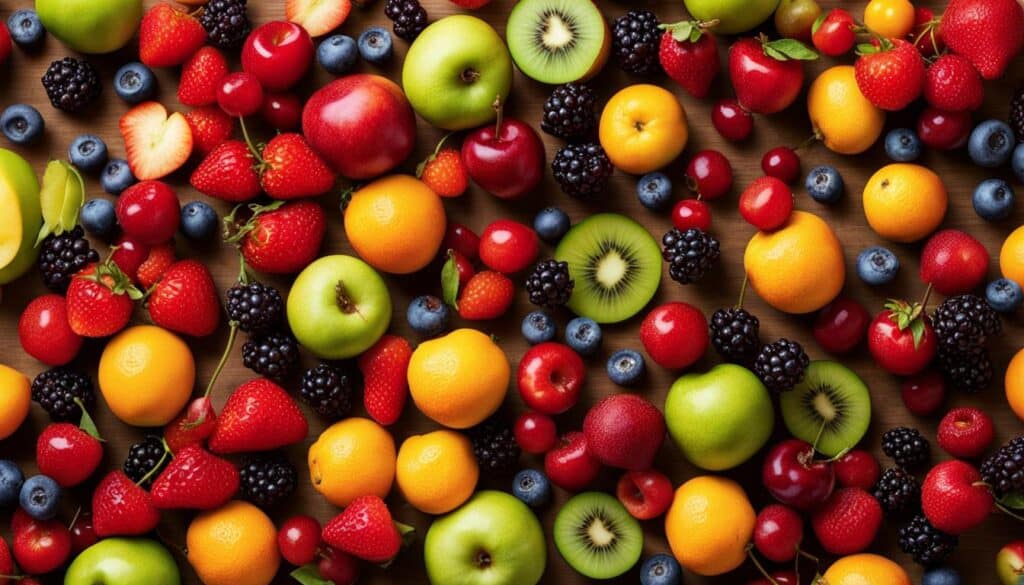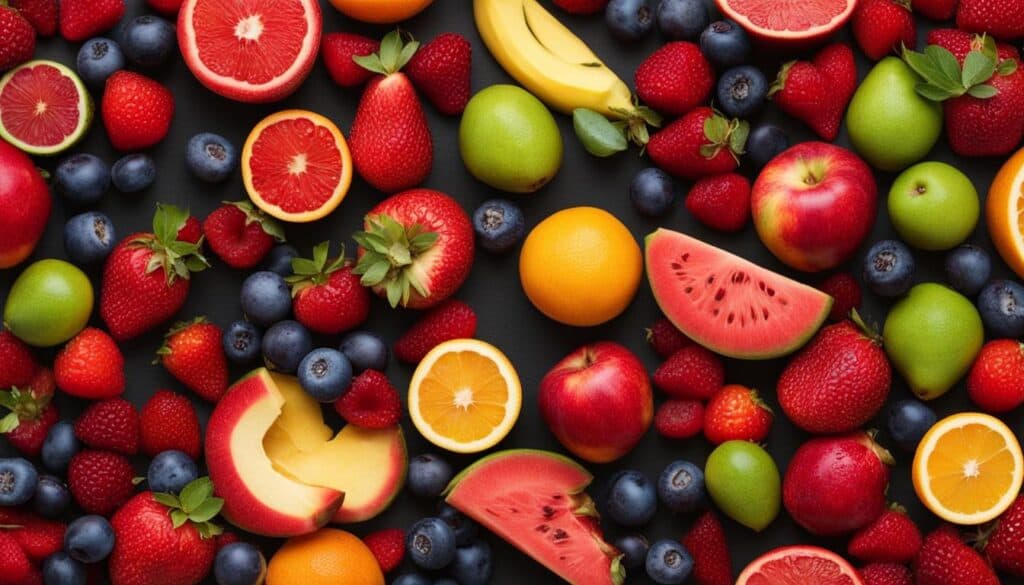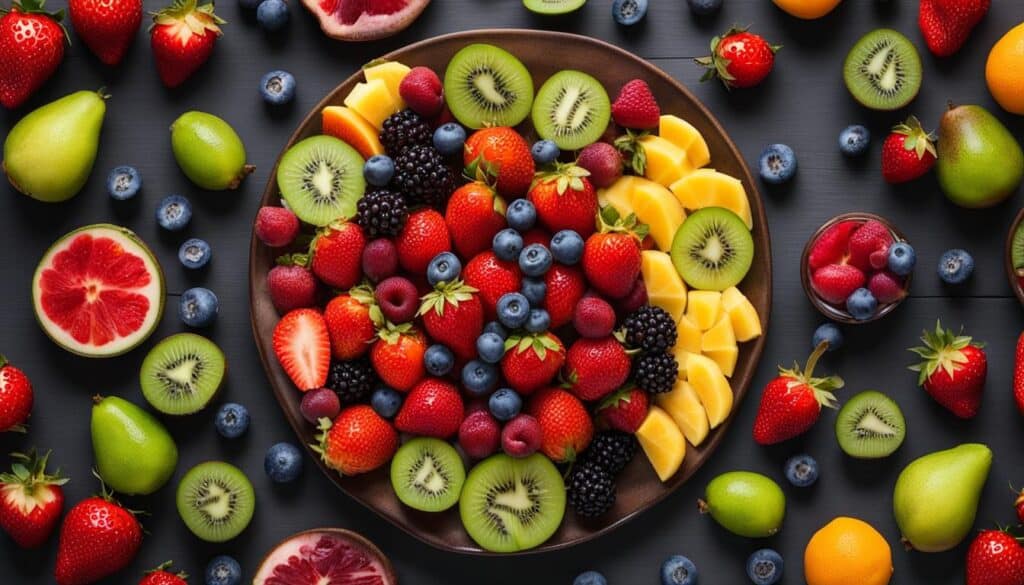Welcome to my informative guide on understanding fruits with high glycemic index (GI). As a nutrition enthusiast, I understand the importance of making informed food choices, especially for individuals managing diabetes or aiming for better blood sugar control. In this guide, we will explore the concept of glycemic index, its impact on blood sugar levels, and how it relates to fruits.
Key Takeaways:
- Fruits with high glycemic index can cause significant spikes in blood sugar levels.
- Factors like acidity, cooking time, fiber content, processing, and ripeness affect a fruit’s glycemic index.
- Choosing low glycemic index fruits can help minimize blood sugar spikes and maintain better blood sugar control.
- The glycemic load, which considers both speed of digestion and carbohydrate content, is also important in understanding a fruit’s impact on blood sugar.
- Incorporating a variety of fruits with low glycemic index into your diet can provide essential nutrients for overall health while managing blood sugar.
How Does the Glycemic Index Work?
The glycemic index (GI) is a valuable tool for managing blood sugar levels and achieving glycemic control. It measures how quickly carbohydrates in a specific food impact blood sugar levels. By understanding the GI of different foods, individuals can make informed choices to manage their blood sugar effectively.
Eating according to the GI involves selecting low GI foods that have a minimal impact on blood sugar levels. These foods are digested slowly, resulting in a gradual rise in blood sugar. By combining low GI fruits and vegetables with higher GI foods, it is possible to balance blood sugar and maintain better glycemic control. The benefits of using the glycemic index extend beyond blood sugar management; it can also help control appetite and promote weight loss.
However, it is important to note that the glycemic index should not be the sole determinant of food choices. Total carbohydrate intake and nutritional value should also be considered. While low GI foods are generally preferred, it’s crucial to choose nutrient-dense options that provide essential vitamins, minerals, and fiber. Balancing carbohydrate intake and considering overall dietary needs are essential components of maintaining healthy blood sugar levels.
How Does the Glycemic Index Work?
The glycemic index works by assigning a numerical value to foods based on their impact on blood sugar levels. Foods with a high GI rating, typically above 70, raise blood sugar levels more significantly and rapidly. In contrast, low GI foods with ratings below 55 have a slower and milder effect on blood sugar. Moderate GI foods fall between 55 and 70.
| Low GI Foods | Moderate GI Foods | High GI Foods |
|---|---|---|
| Apples (GI: 39) | Pineapple (GI: 59) | White bread (GI: 71) |
| Grapefruit (GI: 25) | Grapes (GI: 59) | Watermelon (GI: 72) |
| Oranges (GI: 40) | Pasta (GI: 54) | Potato (GI: 83) |
By incorporating low GI foods into meals, individuals can better manage their blood sugar levels, promoting overall health and well-being.
Benefits and Risks of Using the Glycemic Index

Using the glycemic index (GI) can offer several benefits in terms of blood sugar control and managing diabetes. By choosing foods with a low glycemic impact, individuals can help keep their blood sugar levels stable and avoid significant spikes. This can be particularly beneficial for people with diabetes who need to closely monitor their blood sugar levels.
The main advantage of using the GI is that it provides a tool for making informed decisions about food choices. By selecting low GI foods, individuals can minimize the impact on their blood sugar levels and achieve better glycemic control. This can help prevent the rapid rise and fall of blood sugar, which can lead to feelings of fatigue, hunger, and difficulty in managing diabetes.
“By choosing low GI fruits and vegetables, individuals can regulate their blood sugar levels and reduce the risk of complications associated with diabetes.”
However, it is important to note that relying solely on the GI may not be sufficient for managing diabetes. It is crucial to consider other factors such as total carbohydrate intake and the overall nutritional value of the food. The GI should be used as part of a comprehensive approach to diabetes management, alongside portion control, regular physical activity, and a balanced diet.
| Benefits of Using the GI | Risks of Eating on the GI |
|---|---|
|
|
Overall, incorporating the glycemic index into a diabetes management plan can be valuable in promoting blood sugar control. It allows individuals to make more informed decisions about their food choices and may help reduce the risk of complications associated with diabetes. However, it is important to approach the GI as a tool that complements other strategies for managing diabetes, rather than relying solely on it.
The Glycemic Index of Common Fruits and Vegetables
When it comes to managing blood sugar levels, understanding the glycemic index (GI) of fruits and vegetables can be beneficial. The glycemic index measures how quickly carbohydrates in a specific food raise blood sugar levels. Incorporating low GI fruits and vegetables into your diet can help maintain stable blood sugar levels and support overall health.
Glycemic Index of Fruits
Here are some common fruits and their respective GI values:
| Fruit | Glycemic Index |
|---|---|
| Apple | 38 |
| Grapefruit | 25 |
| Orange | 43 |
| Pear | 38 |
| Watermelon | 76 |
These fruits have a low glycemic index, making them suitable choices for individuals looking to manage their blood sugar levels.
Glycemic Index of Vegetables
Here are some common vegetables and their respective GI values:
| Vegetable | Glycemic Index |
|---|---|
| Carrots | 47 |
| Green Peas | 48 |
| Parsnips | 52 |
| Sweet Potatoes | 44 |
These vegetables have a low glycemic index and can be included in a balanced meal plan for better blood sugar control.
Incorporating Fruits into a Diabetes Eating Plan

Fruit choices play an important role in a diabetes meal plan. However, it’s essential to consider portion sizes and carbohydrate counting to maintain blood sugar control. Fresh, frozen, or canned fruits without added sugars are the best choices for individuals with diabetes. When including fruits in a meal plan, it’s crucial to be mindful of portion sizes and carbohydrate content to avoid blood sugar spikes.
Counting carbs is a valuable strategy to manage blood sugar levels effectively. One serving of fruit usually contains approximately 15 grams of carbohydrates, so it’s essential to track your intake and adjust portion sizes accordingly. Incorporating fruits into a diabetes eating plan can be done by swapping other sources of carbohydrates with fruits. This allows for a balanced meal while still enjoying the nutritional benefits of fruit.
“Fresh, frozen, or canned fruits without added sugars are the best choices for individuals with diabetes.”
It’s important to be cautious with dried fruit and fruit juice due to their higher carbohydrate content and smaller portion sizes. While these options can still be included in moderation, it’s crucial to monitor their intake to avoid blood sugar spikes. It’s also recommended to spread fruit consumption throughout the day, rather than consuming large quantities all at once. This approach can help maintain stable blood sugar levels and support overall glycemic control.
Overall, incorporating fruits into a diabetes eating plan requires careful consideration of portion sizes, carbohydrate counting, and choosing low glycemic index options. By doing so, individuals with diabetes can enjoy the benefits of fruits while maintaining blood sugar control and supporting their overall health.
Fruit and Blood Sugar Levels

Fruits contain carbohydrates and natural sugars, which can raise blood sugar levels. However, fruits are also rich in vitamins, minerals, fiber, and phytochemicals that promote overall health and lower the risk of chronic diseases. Managing blood sugar levels involves counting the carbohydrates in fruit and balancing them with medication, diet, and lifestyle choices. The glycemic index and glycemic load help better understand the effects of fruit on blood sugar levels, with low GI fruits recommended for maintaining glycemic control.
When it comes to managing blood sugar levels, it’s important to consider the amount and type of carbohydrates consumed. Fruits vary in their carbohydrate content, with some containing higher levels than others. By understanding the glycemic index of fruits, individuals can make informed choices to help minimize blood sugar spikes.
The glycemic index measures how quickly carbohydrates in a specific food raise blood sugar levels. Foods with a low GI (less than 55) are digested and absorbed more slowly, resulting in a slower and more gradual rise in blood sugar. On the other hand, foods with a high GI (greater than 70) are digested and absorbed quickly, leading to a rapid increase in blood sugar levels.
To effectively manage blood sugar levels, it’s recommended to choose fruits with a low glycemic index. These include fruits like berries, apples, and pears. These fruits provide the body with important nutrients while minimizing the impact on blood sugar levels. It’s also important to consider the glycemic load, which takes into account both the GI and the portion size of the fruit consumed. This helps give a more accurate representation of the overall impact on blood sugar levels.
Table: Glycemic Index of Common Fruits
| Fruit | Glycemic Index |
|---|---|
| Apple | 39 |
| Berries (mixed) | 40 |
| Pear | 41 |
| Orange | 43 |
| Grapefruit | 50 |
Source: National Tables of Glycemic Index
Fitting Fruit into a Diabetes Meal Plan

When incorporating fruit into a diabetes meal plan, it is important to consider portion sizes, the glycemic impact of different fruits, and the principles of the diabetes plate method. By following these guidelines, individuals with diabetes can enjoy the nutritional benefits of fruit while maintaining stable blood sugar levels.
Understanding the Diabetes Plate Method
The diabetes plate method is a practical and effective way to plan meals for individuals with diabetes. It involves dividing the plate into sections to ensure a balanced intake of carbohydrates, proteins, and non-starchy vegetables. When incorporating fruit into the diabetes plate method, it is recommended to allocate a portion of the plate to fruit alongside other carbohydrate sources.
For example, one quarter of the plate can be dedicated to fruit, while another quarter can be allocated to a starchy carbohydrate, such as whole grains or potatoes. The remaining half of the plate can consist of non-starchy vegetables and a source of lean protein. This approach helps distribute carbohydrates evenly throughout the meal and prevents blood sugar spikes.
Portion Sizes and Glycemic Impact
When fitting fruit into a diabetes meal plan, it is essential to pay attention to portion sizes and the glycemic impact of different fruits. While fruits are generally considered healthy, some have a higher glycemic index than others, meaning they can cause a more significant increase in blood sugar levels.
Choosing fruits with a low glycemic index, such as berries, cherries, and apples, can help minimize blood sugar spikes. It is important to consume fruit in moderation, following the portion sizes recommended by healthcare professionals or dietitians. Generally, a small piece of whole fruit or ½ cup of frozen or canned fruit is equivalent to 15 grams of carbohydrates, which is often considered one serving of fruit.
Tips for Incorporating Fruit
Here are some practical tips for incorporating fruit into a diabetes meal plan:
- Choose fresh or frozen fruit instead of processed fruit or fruit juice, as they often contain added sugars.
- Check portion sizes for dried or processed fruit, as they can be smaller due to higher sugar concentration.
- Spread fruit intake throughout the day rather than consuming a large amount all at once.
- Experiment with different combinations of fruits and non-starchy vegetables to create satisfying and balanced meals.
By following these tips and incorporating fruit into a well-rounded diabetes meal plan, individuals can enjoy the natural sweetness and nutritional benefits of fruits while maintaining stable blood sugar levels.
The Role of Fiber in Fruit and Blood Sugar Control

Fiber plays a crucial role in maintaining stable blood sugar levels when consuming fruits. Fruits that are high in fiber have a slower digestion process, preventing rapid spikes in blood sugar. Additionally, fiber helps to regulate appetite and promote a feeling of fullness, which can aid in maintaining a healthy weight.
A diet rich in fiber from fruits with low glycemic index values can contribute to better blood sugar control and overall health. Some fruits that are particularly high in fiber include blackberries, strawberries, and tomatoes. These fiber-rich fruits provide essential nutrients while helping to keep blood sugar levels in check.
Fiber content in fruits can vary depending on how they are consumed. Fresh fruits typically have higher fiber content than processed fruits or fruit juices, as their natural fiber is retained. It is important to be mindful of portion sizes and consider the overall carbohydrate content when including fruits in a diabetes meal plan.
The Role of Fiber in Blood Sugar Control
“Including fiber-rich fruits in your diet can have a significant impact on blood sugar control. Fiber slows down the digestion process, preventing rapid spikes in blood glucose levels and promoting a feeling of fullness.”
By incorporating fiber-rich fruits into a balanced meal plan, individuals with diabetes can benefit from improved blood sugar management. The combination of low glycemic index values and high fiber content in fruits makes them an ideal choice for maintaining glycemic control and supporting overall health and well-being.
| Fruit | Fiber Content per 100g |
|---|---|
| Blackberries | 5.3g |
| Strawberries | 2g |
| Tomatoes | 1.2g |
The Health Benefits of Fiber
In addition to its role in blood sugar control, fiber offers numerous health benefits. It helps to regulate bowel movements, lowers cholesterol levels, and reduces the risk of heart disease and certain types of cancer. Incorporating fiber-rich fruits into a diabetes meal plan is not only essential for blood sugar control but also for maintaining overall health.
- Fiber slows down the digestion process, preventing rapid spikes in blood sugar.
- Fiber promotes a feeling of fullness, aiding in weight management.
- Fiber regulates bowel movements, promoting healthy digestion.
- Fiber lowers cholesterol levels, reducing the risk of heart disease.
- Fiber reduces the risk of certain types of cancer.
By understanding the role of fiber in fruit and blood sugar control, individuals with diabetes can make informed choices about their dietary intake and maintain better glycemic control. Incorporating a variety of fiber-rich fruits into a balanced meal plan is a simple yet effective strategy for managing blood sugar levels and promoting overall health.
Conclusion
Managing diabetes and maintaining blood sugar control are crucial for overall health and well-being. Incorporating the glycemic index (GI) of fruits into a balanced meal plan can be a valuable tool in achieving these goals. By choosing fruits with a low GI, individuals can minimize blood sugar spikes and promote better glycemic control.
When incorporating fruits into a diabetes meal plan, it is essential to consider portion sizes and total carbohydrate intake. One serving of fruit typically contains around 15 grams of carbohydrates, so it’s important to count carbs and adjust portion sizes accordingly. Fresh, frozen, or canned fruits without added sugars are the best choices, while dried fruits and fruit juices should be consumed in smaller amounts due to their higher carbohydrate content.
Healthy eating goes beyond just managing carbohydrates and blood sugar levels. It is important to also consider the overall nutritional value of fruits. Including a variety of fruits in the diet provides essential vitamins, minerals, fiber, and phytochemicals that support overall health. By incorporating low GI fruits such as apples, grapefruits, and strawberries, individuals can enjoy the benefits of fruits while maintaining glycemic control.
Remember, the glycemic index is just one tool in managing diabetes. It should be used in conjunction with other strategies, such as portion control, a balanced diet, and regular physical activity. By taking a holistic approach to managing diabetes and making informed food choices, individuals can achieve better blood sugar control and lead a healthier lifestyle.
FAQ
What is the glycemic index?
The glycemic index (GI) is a tool used to measure how quickly the carbohydrates in a specific food impact blood sugar levels.
How does the glycemic index work?
The glycemic index measures how quickly the carbohydrates in a food raise blood sugar levels. Foods with a high GI raise blood sugar more significantly.
What factors affect a food’s glycemic index?
Factors that affect a food’s GI rating include its acidity, cooking time, fiber content, processing, and ripeness.
What is the glycemic load?
The glycemic load takes into account both the speed of digestion and the amount of carbohydrates in a serving, providing a more complete measure of the impact on blood sugar.
How can the glycemic index help manage blood sugar levels?
Eating according to the GI can help manage post-meal blood sugar levels and determine appropriate combinations of food for better blood sugar control.
What are low glycemic index fruits and vegetables?
Common fruits with low GI include apples, grapefruit, oranges, pears, and watermelon. Common vegetables with low GI include carrots, green peas, parsnips, and sweet potatoes.
How should fruits be incorporated into a diabetes eating plan?
Fresh, frozen, or canned fruits without added sugars are the best choices for individuals with diabetes. Portion sizes should be considered when counting carbs, and fruits can be eaten as a replacement for other sources of carbohydrates.
Can fruits raise blood sugar levels?
Fruits contain carbohydrates and natural sugars, which can raise blood sugar levels. However, they are also rich in vitamins, minerals, fiber, and phytochemicals that promote overall health and lower the risk of chronic diseases.
How much fruit can be eaten in a diabetes meal plan?
For individuals who count carbs, small portions of whole fruit or ½ cup of frozen or canned fruit can be equivalent to 15 grams of carbohydrates. Portion sizes should be checked for dried or processed fruit due to added sugars.
What is the role of fiber in fruit and blood sugar control?
Fruits are high in fiber, which slows down digestion and prevents blood sugar spikes. Fiber also helps one feel fuller, aiding in maintaining a healthy weight.





Leave a Reply